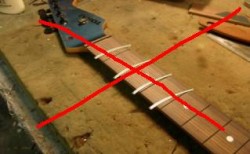After a few weeks/months/years of playing your new guitar – it depends on how much you play – you’ll notice a bit of rattle creeping into the sound. Close examination of the playing surface will reveal worn areas. The playing surface, onto which the string is pressed, eventually wears down, creating a lower contact point between the string and fret. These new, lower contact points prevent sufficient clearance between the string, when fretted, and the next fret up.
Many folk are under the impression that they now need a re-fret but, providing there’s still enough metal left, the situation can be remedied by simply having the frets Levelled and Re-profiled.

This operation involves using a special tool to skim all the fret-tops at the same time, creating a dead-level playing surface. The frets are then individually rounded off to remove the edges created by the levelling process. To complete the job I dress the fret ends, then use different grades of emery paper to polish the fret crowns in order to promote smooth string bending across their surface and finally, I rejuvenate the fingerboard using some Lemon Oil.
Of course, because material has been removed from the frets, the guitar will now need to be set up again. The string slots in the nut will be too high as will the saddles at the bridge. A subtle narrowing of the frets to recreate their relative proportions will sometimes be required, in order to compensate for any perceived change in feel, given they are now less tall. However, due to their original profile, the more extreme types of frets are always going to feel slightly different second time or third time around. The chances are, if you don’t let the wear go too deep, you’ll be able to have a level/re-profile job done twice, maybe even three times, before a re-fret becomes unavoidable.
It’s worth noting, because wood-under-tension will sometimes continue to move after initial adjustments have been made, that a further tweaking of the set-up parameters may be required. Any repairer worth their salt will consider this an extension of the original job and should cover it free of charge.
Like most repair practitioners, I rely on customer feedback as a means of monitoring aftermarket satisfaction and I’m always open to sensible comments from anyone with a genuine concern or query. It’s only by listening that I’m able to tailor my work to suit the customer and, in turn, hopefully provide a better service.